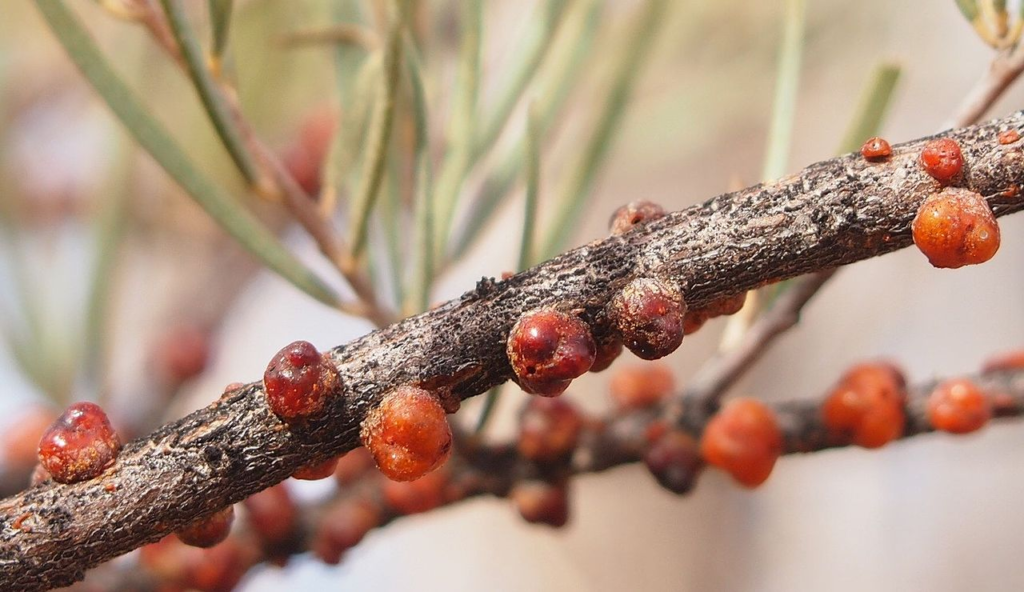
Honeydew

Honeydew is a sugar-rich sticky liquid, secreted by aphids and some scale insects as they feed on plant sap. When their mouthpart penetrates the phloem, the sugary, high-pressure liquid is forced out of the anus of the aphid. Honeydew is particularly common as a secretion in hemipteran insects and is often the basis for trophobiosis. Some caterpillars of Lycaenidae butterflies and some moths also produce honeydew.
- Delabie JH (2001). “Trophobiosis Between Formicidae and Hemiptera (Sternorrhyncha and Auchenorrhyncha): an Overview” (PDF). Neotropical Entomology. 30 (4): 501–516. doi:10.1080/00222930150215378. S2CID 84918015.
- Maschwitz U, Dumpert K, Tuck KR (1986). “Ants feeding on anal exudate from tortricid larvae: a new type of trophobiosis”. Journal of Natural History. 20 (5): 1041–1050. doi:10.1080/00222938600770751.

Honeydew producing insects, like cicadas, pierce phloem ducts to access the sugar rich sap. The sap continues to bleed after the insects have moved on, leaving a white sugar crust called manna. Ants may collect, or “milk”, honeydew directly from aphids and other honeydew producers, which benefit from their presence due to their driving away predators such as lady beetles or parasitic wasps—see Crematogaster peringueyi. Animals and plants in a mutually symbiotic arrangement with ants are called Myrmecophiles.
- Lee AK (1985-03-21). Evolutionary Ecology of Marsupials. Cambridge University Press. p. 33. ISBN 9780521252928. Retrieved 25 August 2019.
In Madagascar, some gecko species in the genera Phelsuma and Lygodactylus are known to approach flatid plant-hoppers on tree-trunks from below and induce them to excrete honeydew by head nodding behaviour. The plant-hopper then raises its abdomen and excretes a drop of honeydew almost right onto the snout of the gecko.
- Fölling M, Knogge C, Böhme W (February 2001). “Geckos are milking honeydew-producing planthoppers in Madagascar”. Journal of Natural History. 35 (2): 279–84. doi:10.1080/00222930150215378. S2CID 84918015
Honeydew can cause sooty mold—a bane of gardeners—on many ornamental plants. It also contaminates vehicles parked beneath trees, and can then be difficult to remove from glass and bodywork. Honeydew is also secreted by certain fungi, particularly ergot. Honeydew is collected by certain species of birds, mosquitoes, wasps, stingless bees and honey bees, which process it into a dark, strong honey (honeydew honey). This is highly prized in parts of Europe and Asia for its reputed medicinal value. Parachartergus fraternus, a eusocial wasp species, collects honeydew to feed to their growing larvae. Recent research has also documented the use of honeydew by over 40 species of wild, native, mostly solitary bees in California.
- Ergot of Rye Archived 2018-08-09 at the Wayback Machine, APSnet.org, The American Phytopathological Society
- Peach DA, Gries R, Young N, Lakes R, Galloway E, Alamsetti SK, et al. (February 2019). “Aedes aegypti (L.) to Aphid Honeydew”. Insects. 10 (2): 43. doi:10.3390/insects10020043. PMC 6409638. PMID 30717169.
- Peach DA, Gries G (2019). “Mosquito phytophagy – sources exploited, ecological function, and evolutionary transition to haematophagy”. Entomologia Experimentalis et Applicata. 168 (2): 120–136. doi:10.1111/eea.12852. ISSN 1570-7458.
- Koch H, Corcoran C, Jonker M (2011). “Honeydew Collecting in Malagasy Stingless Bees (Hymenoptera: Apidae: Meliponini) and Observations on Competition with Invasive Ants” (PDF). African Entomology. 19 (1): 36–41. doi:10.4001/003.019.0111. S2CID 83522254. Archived from the original (PDF) on 2012-03-19.
- Sidnei M, Noll FB, Zucchi R (2004). “Caste Flexibility and Variation According to the Colony Cycle in the Swarm-founding Wasp, Parachartergus Fraternus (Gribodo) (Hymenoptera: Vespidae: Epiponini)”. Journal of the Kansas Entomological Society. 77 (4): 470–83. doi:10.2317/E-40.1. S2CID 84967255.
- Meiners JM, Griswold TL, Harris DJ, Ernest SK (August 2017). “Bees without Flowers: Before Peak Bloom, Diverse Native Bees Find Insect-Produced Honeydew Sugars”. The American Naturalist. 190 (2): 281–291. doi:10.1086/692437. PMID 28731796. S2CID 206004844.
Religion and mythology
In Norse mythology, dew falls from the ash tree Yggdrasil to the earth, and according to the Prose Edda book Gylfaginning, “this is what people call honeydew and from it bees feed.”
- Faulkes A (1995). Edda. Everyman. pp. 18–19. ISBN 0-460-87616-3.
In Greek mythology, méli, or “honey”, drips from the Manna–ash, (Fraxinus ornus), with which the Meliae, or “ash tree nymphs“, nursed the infant god Zeus on the island of Crete, (as in the Hymn to Zeus by Callimachus).[citation needed]
- Clauss JJ (1993). The Best of the Argonauts: The Redefinition of the Epic Hero in Book 1 of Apollonius’s Argonautica. Hellenistic culture and society. Vol. 10. University of California Press. p. 170. ISBN 978-0-520-07925-0.
Honey-dew is referenced in the last lines of Samuel Coleridge‘s poem Kubla Khan, perhaps because of its mythological connotations:
And all who heard should see them there,
And all should cry, Beware! Beware!
His flashing eyes, his floating hair!
Weave a circle round him thrice,
And close your eyes with holy dread,
For he on honey-dew hath fed,
And drunk the milk of Paradise.
In the Hebrew Bible, while the Israelites are wandering through the desert after the Exodus, they are miraculously provided with a substance, manna, that is sometimes associated with honeydew. Exodus 16:31 provides a description: “it was like coriander seed, white, and the taste of it was like wafers made with honey.”
Nectar producing trees

Dates
The Ommatissus lybicus is attracted to certain cultivars of the date palm tree. The honeydew producing insects preferred the Medjhool variety to the Deglet Noor in Israel, where they have been observed in the Arava Valley. Very dense insect populations may have some adverse effects. Different methods of controlling the insects, including natural and chemical, have been studied.
- Howard FW (2001). Insects on Palms. p. 154. ISBN 9780851997056. Retrieved 25 August 2019.
Eucalyptus
In eucalypt forests, production of both the honeydew nectar and manna tends to increase in spring and autumn. Eucalyptus can produce even more manna than honeydew nectar. The sugar glider possum eats both, licking the nectar from branches. Other species attracted to the nectar include the feathertail glider, brush-tailed phascogale, and brown antechinus. Most trees are not able to produce sap if the phloem duct becomes damaged by mechanical processes.
- Lee AK (1985-03-21). Evolutionary Ecology of Marsupials. Cambridge University Press. p. 33. ISBN 9780521252928. Retrieved 25 August 2019.
Oaks
The acorn weevil (Curculio glandium) habitually bores into the young acorns of oak trees. This injury can cause the tree to release a sweet honeydew, thought to attract wasps that can parasitize the weevil within its acorns. Honey bees sometimes collect this substance, in addition to honeydew from aphids feeding in oak forests, and use it to produce oak honey, an unusual varietal sold by specialist beekeepers.
- “Oak honey comes from Acorns”. The Raw Honey Shop. Retrieved 2022-09-25.
- “Miel Morbihan Bretagne”. L’Abeille de Lanvaux (in French). Retrieved 2022-09-25.
Tamarisk
Two scale insects in the Sinai, Trabutina mannipara and Najacoccus serpentinus feed on Tamarisk trees. They secrete a sugary nectar that turns white when it hardens, resembling certain whitish flakes described in the Hebrew scriptures.
- Jolivet P (1992). Insects and Plants: Parallel Evolution & Adaptations, Second Edition. Sandhill Crane Press. p. 119. ISBN 9781877743108. Retrieved 25 August 2019.
See also
In biology, a lerp is a structure of crystallized honeydew produced by larvae of psyllid bugs as a protective cover. Jumping plant lice or psyllids, are a family of small plant-feeding insects that tend to be very host-specific, i.e. each plant-louse species only feeds on one plant species (monophagous) or feeds on a few closely related plants (oligophagous). Together with aphids, phylloxerans, scale insects and whiteflies, they form the group called Sternorrhyncha, which is considered to be the most “primitive” group within the true bugs (Hemiptera).These animals are commonly referred to as lerp insects, of which there are over 300 species in Australia. Lerps are energy rich, consisting mostly of starch, with some proteins and fats. They are eaten by flying foxes, possums and birds such as pardalotes and honeyeaters.
“Lerps – One of nature’s sweet offerings”. Land for Wildlife. 2019-08-07. Retrieved 2021-10-10.
The word is derived from the Australian Aboriginal language Wemba-Wemba. Lerps were traditionally eaten by Indigenous people, and could be stored as dry balls for future use.
- Australian Aboriginal Words in English. Melbourne: Oxford University Press. 2006 [1990]. p. 103. ISBN 9780195540734.
- Faast, Renate; Clarke, Philip A.; Taylor, Gary S.; Salagaras, Renée L.; Weinstein, Philip (2020-09-01). “Indigenous Use of Lerps in Australia: So Much More Than a Sweet Treat”. Journal of Ethnobiology. 40 (3): 328–347. doi:10.2993/0278-0771-40.3.328. ISSN 0278-0771



Leave a Reply